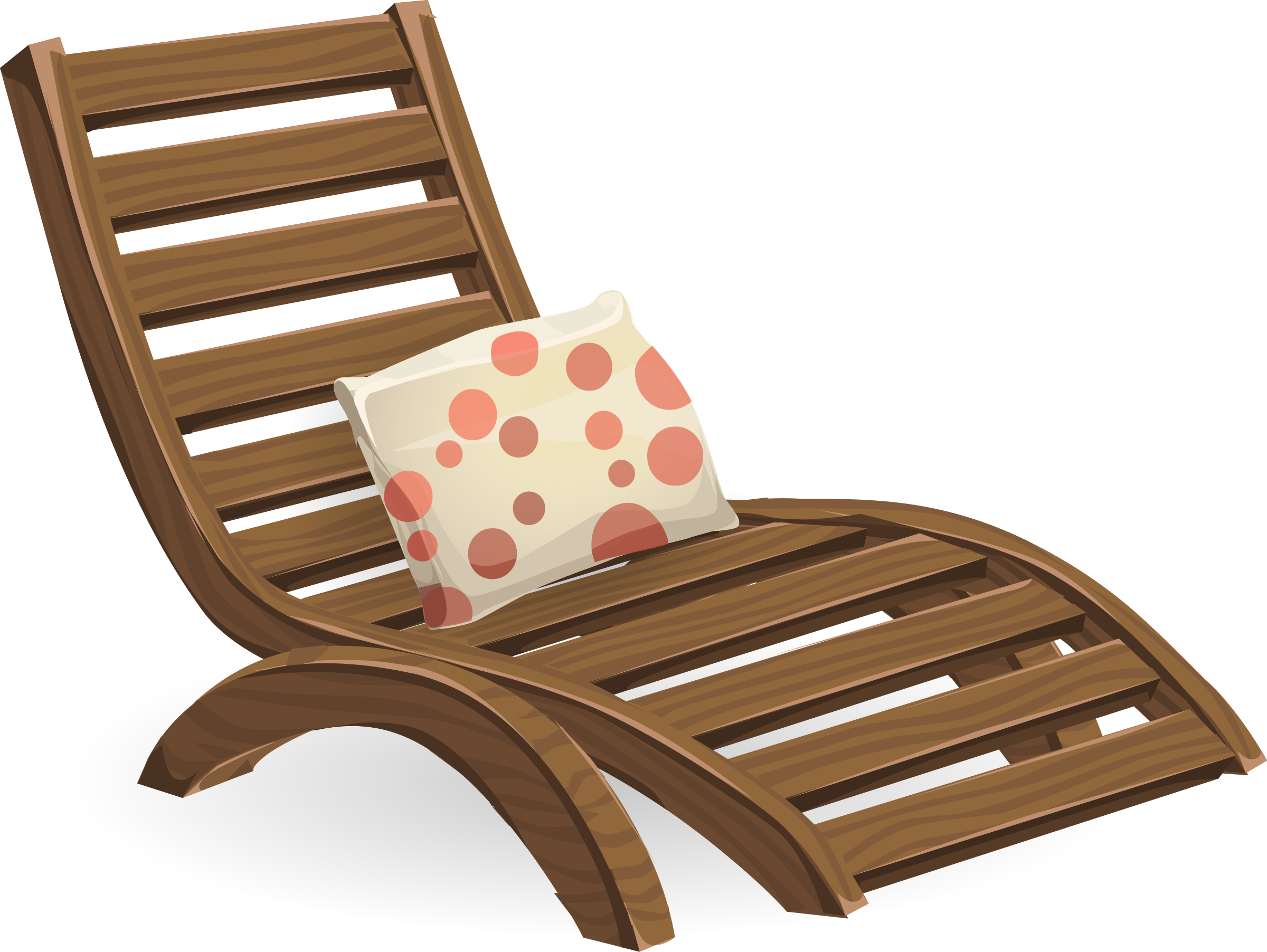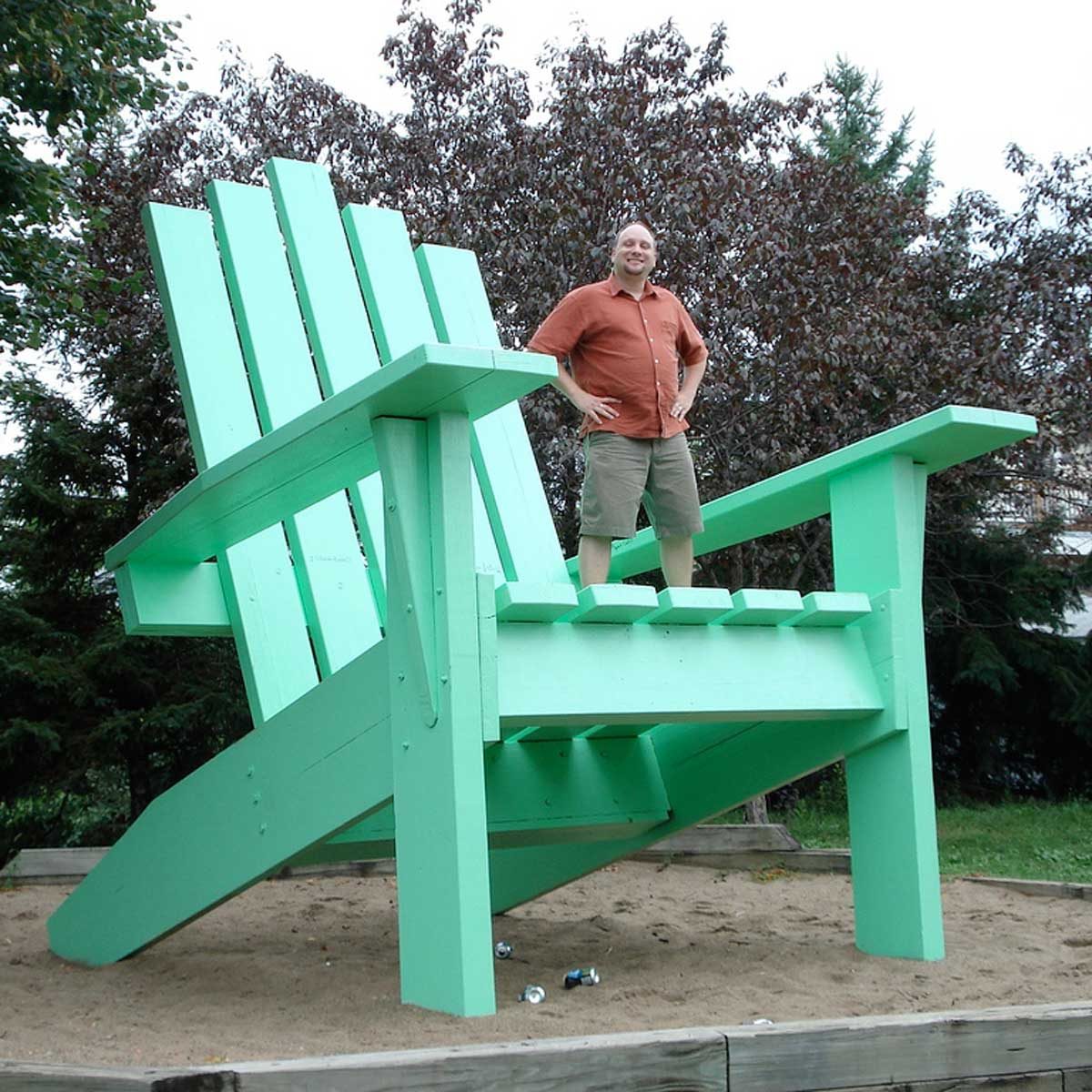The Giant Wooden Lawn Chair

The concept of oversized lawn furniture, particularly giant wooden lawn chairs, represents a unique and often whimsical approach to outdoor design. These colossal creations serve not only as functional seating but also as striking statement pieces, adding a touch of whimsy and grandeur to any outdoor space.
The History and Origin of Oversized Lawn Furniture
The origins of oversized lawn furniture can be traced back to the Victorian era, a period characterized by a fascination with grandeur and elaborate displays of wealth. During this time, wealthy individuals often commissioned custom-made furniture, including oversized chairs and tables, to adorn their expansive gardens and estates. These pieces were typically crafted from materials like wood, wrought iron, and stone, reflecting the craftsmanship and artistry of the era.
The trend of oversized lawn furniture continued into the 20th century, with notable examples emerging from the mid-century modern design movement. This era saw the rise of iconic pieces like the “Barcelona Chair” by Mies van der Rohe and Lilly Reich, which, though not technically oversized, embodied the principles of simplicity, functionality, and scale. These pieces, along with others, influenced the design and aesthetic of oversized lawn furniture in subsequent decades.
Design Inspirations for a Giant Wooden Lawn Chair
Giant wooden lawn chairs can draw inspiration from a variety of sources, including historical styles, architectural elements, and natural forms.
- Historical Styles: Designs can be inspired by traditional styles like Victorian, Art Deco, or mid-century modern, capturing the essence of these eras through their unique proportions, materials, and ornamentation.
- Architectural Elements: The form and structure of a giant wooden lawn chair can be inspired by architectural elements such as columns, arches, or even entire building facades. This approach allows for the creation of visually striking and imposing pieces that blend seamlessly with the surrounding environment.
- Natural Forms: Nature provides a rich source of inspiration for giant wooden lawn chairs. Designs can mimic the organic shapes of trees, rocks, or even animal forms, creating a sense of harmony and connection with the natural world.
Materials and Construction Methods
Giant wooden lawn chairs are typically constructed from durable and weather-resistant hardwoods such as oak, cedar, or teak. These woods offer strength, longevity, and natural beauty, making them ideal for outdoor use.
- Wood Selection: The choice of wood depends on factors such as desired aesthetic, budget, and the intended environment. Hardwoods like oak and cedar are known for their strength and durability, while teak is prized for its natural resistance to decay and insects.
- Construction Methods: Construction methods for giant wooden lawn chairs involve traditional woodworking techniques such as mortise and tenon joinery, dovetail joints, and glue lamination. These methods ensure the structural integrity and longevity of the piece. Modern techniques, such as CNC machining, can also be employed for precise and efficient fabrication.
- Finishing: Once constructed, giant wooden lawn chairs are typically finished with protective coatings such as oil, stain, or paint. These finishes enhance the wood’s natural beauty, protect it from the elements, and provide a smooth and durable surface.
Examples of Giant Wooden Lawn Chairs from Different Cultures and Time Periods
Giant wooden lawn chairs have been a recurring theme in various cultures and time periods.
- Ancient Egypt: The ancient Egyptians were known for their colossal sculptures and monuments, and this grandeur extended to their furniture as well. Examples of oversized wooden chairs have been discovered in tombs and temples, reflecting the power and prestige of the ruling class.
- Victorian Era: The Victorian era witnessed a surge in popularity for oversized lawn furniture, often made from wood and adorned with intricate carvings and embellishments. These pieces were a testament to the wealth and status of their owners and served as focal points in their expansive gardens.
- Mid-Century Modern: The mid-century modern design movement emphasized functionality and simplicity, resulting in oversized chairs with clean lines and minimalist designs. These pieces were often made from wood or metal and were intended to blend seamlessly with the surrounding architecture.
Functionality and Practicality of a Giant Wooden Lawn Chair

A giant wooden lawn chair, a whimsical and eye-catching addition to any garden or outdoor space, presents both functional and practical considerations. While its size and unique design offer distinct advantages, it’s crucial to weigh the potential challenges and limitations before incorporating it into your outdoor landscape.
Practical Uses of a Giant Wooden Lawn Chair
The size and design of a giant wooden lawn chair offer a range of practical uses beyond typical seating. It can serve as a unique focal point in a garden, attracting attention and sparking conversation. The ample surface area provides a platform for various activities, such as:
- Picnic spot: The large surface can comfortably accommodate multiple people for a picnic or outdoor meal.
- Stage for performances: The chair’s height can create a mini-stage for small performances or storytelling sessions.
- Play area: Children can use the chair as a climbing structure or a base for imaginative play.
- Garden decor: The chair’s presence can add a touch of whimsy and grandeur to any garden setting.
Challenges and Considerations for Design and Use
The sheer size of a giant wooden lawn chair presents both design and practical challenges:
- Construction and Materials: Building a chair of this magnitude requires specialized woodworking skills and sturdy materials to ensure stability and longevity.
- Transportation and Installation: Moving and installing a giant wooden chair can be a logistical challenge, requiring specialized equipment and planning.
- Maintenance: The large surface area necessitates regular cleaning and maintenance to prevent wear and tear and ensure its longevity.
- Accessibility: The chair’s height may pose accessibility issues for individuals with mobility limitations.
Comparison to Standard-Sized Seating, Giant wooden lawn chair
A giant wooden lawn chair offers a unique experience compared to standard-sized seating:
- Pros:
- Provides a large, communal seating area.
- Offers a unique focal point and conversation starter.
- Can be adapted for various uses beyond seating.
- Cons:
- Requires significant space and may not be suitable for smaller gardens.
- Can be challenging to construct, transport, and maintain.
- May not be accessible to all individuals.
Hypothetical Scenario Showcasing Functionality
Imagine a garden party where guests gather around a giant wooden lawn chair. Children climb onto its wide armrests and play hide-and-seek amongst its sturdy legs. Adults gather on the chair’s spacious surface, enjoying a picnic lunch and lively conversation. Later, a musician takes center stage on the chair’s elevated platform, serenading the guests with a beautiful melody. The giant wooden lawn chair becomes the heart of the party, a place for laughter, connection, and unforgettable memories.
The Giant Wooden Lawn Chair in Art and Culture

The presence of oversized furniture in art and culture often transcends its literal function, serving as a potent symbol of scale, perspective, and the relationship between human beings and their environment. This essay explores the artistic interpretations of giant wooden lawn chairs, analyzing their symbolic significance, examining their presence in art, literature, and film, and considering their impact on the aesthetics of a landscape.
Symbolic Interpretations of Oversized Furniture
The concept of oversized furniture, particularly giant wooden lawn chairs, evokes a sense of the surreal and the playful. These objects, often depicted in a domestic setting, challenge our perception of scale and create a sense of wonder. They can be interpreted as:
- A Commentary on Consumerism: The sheer size of these chairs can be seen as a satirical commentary on the excesses of consumer culture, where larger-than-life objects are often associated with status and wealth.
- A Representation of Childhood Fantasy: The whimsical nature of oversized furniture often evokes a sense of childhood fantasy, reminding us of a time when the world seemed larger and more magical.
- A Symbol of Isolation or Loneliness: In some interpretations, the vastness of the chair can be seen as a symbol of isolation or loneliness, emphasizing the vastness of the human experience.
Giant Wooden Lawn Chairs in Art, Literature, and Film
Giant wooden lawn chairs have found their way into various forms of artistic expression. Here are some notable examples:
- Claes Oldenburg’s “Giant Three-Way Plug” (1967): This iconic sculpture, featuring a colossal plug, embodies Oldenburg’s signature style of transforming everyday objects into monumental forms. It is reminiscent of a giant wooden lawn chair, evoking a sense of playfulness and absurdity.
- “The Giant Wooden Lawn Chair” by J.D. Salinger (1951): This short story, although fictional, explores the psychological impact of a giant wooden lawn chair on a young boy’s perception of reality. The chair becomes a symbol of his loneliness and alienation.
- “The Big Lebowski” (1998): In this cult classic film, the giant wooden lawn chair becomes a symbol of the protagonist’s carefree and unconventional lifestyle. Its presence in the film adds a touch of absurdity and humor.
Impact on Landscape Aesthetics
The introduction of a giant wooden lawn chair into a landscape can significantly alter its aesthetic qualities. It can:
- Create a Sense of Scale: The chair’s immense size provides a dramatic contrast to the surrounding environment, emphasizing the vastness of the landscape and highlighting the human scale.
- Introduce a Playful Element: The whimsical nature of the chair can add a touch of playfulness and humor to a landscape, transforming it from a purely functional space into a site of amusement and contemplation.
- Challenge Traditional Aesthetics: The chair’s unconventional form can disrupt traditional landscape aesthetics, forcing viewers to reconsider their expectations of the natural world.
A Fictional Narrative
The sun dipped below the horizon, casting long shadows across the vast expanse of the field. A giant wooden lawn chair, its weathered surface etched with the passage of time, stood sentinel, its back facing the setting sun. A solitary figure, a young girl named Alice, sat perched on the edge of the chair’s immense seat, her legs dangling over the precipice. The wind whispered through the tall grass, carrying with it the scent of wildflowers and the faintest hint of salt from the distant ocean. Alice closed her eyes, letting the gentle breeze caress her face. She felt small, insignificant, yet strangely at peace. The chair, a silent witness to the passing seasons, seemed to hold her in its embrace, offering a sense of security and wonder. The giant wooden lawn chair had become a sanctuary, a place where Alice could escape the complexities of the world and simply be.
While a giant wooden lawn chair might seem like a whimsical idea, for those seeking a more practical and portable option, the cuyler solid wood folding adirondack chair offers a comfortable and convenient solution. This chair folds for easy storage and transport, making it perfect for taking to the park, beach, or even just enjoying your backyard.
Unlike a giant wooden lawn chair, it won’t take up a ton of space when not in use, but it still provides a classic and comfortable seating experience.
Imagine a giant wooden lawn chair, so big you could practically lounge on it with a whole family. While that might be a bit impractical, it’s certainly a whimsical thought! The concept of a giant chair brings to mind the importance of comfort and relaxation, which is precisely what makes wooden relax chair design so captivating.
These chairs, though not giant, are designed to provide the perfect sanctuary for unwinding, and they often incorporate natural elements that complement the outdoors, much like our imaginary giant lawn chair.
